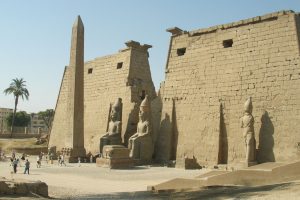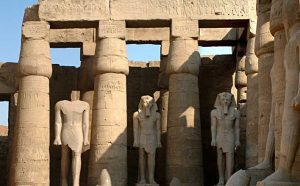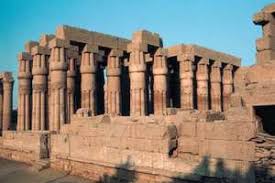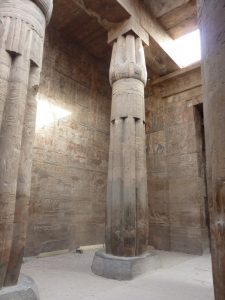
King Amenhotep III (of the Eighteenth Dynasty) and the son of Tuthmosis IV built the inner part of the Temple of Luxor, close to the Nile, just to the south of the city. The temple was completed during the reign of Ramses II of the Ninth Dynasty. Like all Egyptian temples, it was planned along traditional lines: it contained a sanctuary with surrounding chambers, a large colonnade hall, the Hypostyle Hall and the Open Court. Luxor Temple was dedicated to the Triad of Thebes. "Amun Re", the patron god of Thebes, his wife (Mut), and his son (Khunt was called "Ipet resyt," which means the Southern Opet, or the Place of the Seclusion of Amun-Re). It was directly connected to the Karnak Temple, the main cult center of Amun-Re who sometimes took the shape of god Min, the god of fertility, and they together form god 'K3mwt.f.' This combination between Amun and Min only takes place during the Opet Festival.
- The Opet Feast
The Opet was being celebrated in the 2nd month of inundation. During this festival, a statue of Amun and Min was carried in a procession from Karank to Luxor in a ceremony called “The Beautiful Opet”. Lasting for 24 days, this festival was one of the most important ones in Egypt’s religious calendar. The procession between the temples and the ceremonies, held at Luxor, are shown on the outer walls of the shrine of Ramses III in the Great Court at Karnak and on the walls of Colonnade of Amenhotep III at Luxor Temple.
- The Sphinx Avenue Before Luxor Temple
 Entering the Temple of Luxor from north, before the main body of the temple, one sees the Thirtieth Dynasty's Avenue of Sphinxes built by Nectanbo I and this avenue extending three miles towards Karnak temples. These human-headed sphinxes take the facial features of king Nectanbo I. The avenue is paved with limestone slabs. To the east are the remains of small Chapel of Taharqa (of the XXV Dynasty) dedicated to goddess Hathor. Also enclosed at this area is a chapel built by Hadrian dedicated to Serapis (one of the major building projects of the Romans when they converted the area into fortified garrison). The temple was built inside-out as the older buildings date back to the reign of Amenhotep III and are located at the southern end of the temple, while those built by Ramses II are more modern and they occupy the northern part.
Entering the Temple of Luxor from north, before the main body of the temple, one sees the Thirtieth Dynasty's Avenue of Sphinxes built by Nectanbo I and this avenue extending three miles towards Karnak temples. These human-headed sphinxes take the facial features of king Nectanbo I. The avenue is paved with limestone slabs. To the east are the remains of small Chapel of Taharqa (of the XXV Dynasty) dedicated to goddess Hathor. Also enclosed at this area is a chapel built by Hadrian dedicated to Serapis (one of the major building projects of the Romans when they converted the area into fortified garrison). The temple was built inside-out as the older buildings date back to the reign of Amenhotep III and are located at the southern end of the temple, while those built by Ramses II are more modern and they occupy the northern part.
- The First Pylon of Luxor Temple
The Luxor Temple is fronted by a 24m high and 65m wide pylon of Ramses II. The outer walls of the pylon are decorated by sunk relief representing the Battle of Kadesh between King Ramses II and the Hittites of Syria in the 5th year of his reign. The Western Tower (right) represents the King holding a conference with his advisors in his tent. Nearby, he is shown driving a war chariot into the battle. While the Eastern Tower (left) represents the Battle of Kadesh and Ramses II still in his chariot hurling arrows at the surrounding enemies, dead and wounded lie beneath his feet and the enemy flee, in confusion to the fortress of Kadesh. On the jambs of the gateway, Ramses II stands before Amun and Amunet. Other later kings, particularly those of the Nubian Dynasty, also recorded their military victories on these walls (Shabaka on the inner pylon walls).
The pylon towers once supported four enormous cedar-wood flag masts from which pennants streamed. In front of the pylon two obelisks were erected, the one still standing there is the eastern one. It is about 25m high and 256 tons weight. The other one removed in 1836 by Mohamed Ali Pasha to be sent as a gift to France in exchange for the clock in the Citadel. It is now standing in "La Place de la Concord" in Paris. It measures 22.5m in height and weighs 227 tons. Each obelisk was erected on a base with four baboons representing the adorers of the son. Also in front of the pylon, there were six colossal statues of Ramses II, two of them seated, once flanked the entrance, today only the two seated ones have survived. The seated statue on the left shows one princess and Queen Nefertari, carved in a much smaller scale between the King’s legs. The throne of the King is decorated with the Nile gods binding together the Two Lands of Egypt.

- The First Court of Ramses II at Luxor Temple

Measuring about 57m long and 51m wide, the First Court of Ramses II lies behind the First Pylon of Luxor Temple. It has 4 double rows of 74 columns around its 4 sides. These columns are papyrus bud columns and the arcades used to be roofed. The columns are decorated by scenes of Ramses II before different deities. Standing colossi statues of Ramses II were placed between the 1st row of columns in the southern half. On the outside walls of this court are depicted scenes of Ramses II's campaigns against the Hittites in Syria. The First Pylon, built by Ramses II, is out of alignment with the axis established by the other buildings of Amenhotep III. This non-alignment or different angler may have resulted from the fact that Ramses II wanted to include the three small shrines, built during the reigns of Hatshepsut and Tuthmose III for the triad of Thebes, in his court. Some scholars also think that the alignment may have been made, so that the pylon would be on the same axis as the processional way leading to Karnak Temple. The three shrines are located at the northwest side of the court, they not only bear the names of Hatshepsut and Tuthmosis III but also the name of Ramses II, who restored them. Each shrine contains scenes of the King with the deity of the shrine. The eastern side of the court is now partly occupied by the Mosque of al-Hajjaj which dates back to the Ayyubid period. This mosque is higher than the court of Ramses II as this court was completely buried under the ground, thus the mosque was built on the ground level above the buried court. The inner walls of the court are decorated with scenes of the king making offerings with chanting priests and of Thoth recording gifts. On the southern wall of the court, there is a scene of the pylon in all its glory with flags flying. Scenes also show a group of bulls led to the temple for sacrifice. The rear wall shows seventeen sons of Ramses II approached the temple and their names are inscribed above each figure, the sons appear in their birth order, before them is a finely drawn representation of the first pylon of Luxor with flags, obelisks and statues. In the left-rear corner of the court, there is a statue of Ramses and Queen Nefertari (this statue originally carved for Amenhotep III, usurped by Ramses II).

- The Second Pylon at Luxor Temple
The Second Pylon at Luxor Temple was also built by King Ramses II. On each side of its gateway, there is one statue of Ramses II. The one in the left shows queen Nefertari carved between the King’s legs, and on the throne, there is a representation of the (sema tawy). At the back of the pylon, there is an underway preparation for one of Luxor extensive calendar of festivals, “it’s the feast of god Min, god of fertility in ancient Egypt”. The scenes show the King making offerings to Min and being received by Montu. Most of the text is of Ramses II but Pendjem appeared with his family as well.
 - The Colonnade of Amenhotep III at Luxor Temple
- The Colonnade of Amenhotep III at Luxor Temple
The Colonnade of Pharaoh Amenhotep III enclosed within the Complex of the Luxor Temple is the first part of the temple made by this King. It consists of fourteen large open papyrus capitals columns about 16 meters high, arranged to mark a high processional avenue as they still support their huge architrave blocks, however, Tutankhamen, Horemheb, Seti I, Ramses II and Seti II inscribed their names on this colonnade. Tutankhamen and Horemheb decorated the walls of the colonnade with the Opet Festival when god Amun visited the Southern Harem. These scenes are considered one of the finest works of the Eighteenth Dynasty. On the right wall, the procession begins at the gate of Karnak Temple. On the opposite wall, there are scenes of the return of the Sacred Bark to the Luxor Temple including the sacrificial bulls. Today, this ceremony is performed by the Muslims in a festival called the “mawled”. Resembling the Opet Festival, this one is celebrated each year in the month of Shaaban. Muslim Sheikhs emerge from the Mosque of Abu al-Hajjaj (Haggag) bearing 3 small boats which they place on carriages to traverse the city, the city is bedecked with flowers, dancing and clapping to greet the procession.

- The Court of Amenhotep III at Luxor Temple
The Court of Amenhotep III measures 45 m. long by 56 m. wide with double rows of papyrus columns on three sides. The northern end was originally the entrance to the temple. These columns are well preserved except at the northern end.
- The Hypostyle Hall at Luxor Temple

The Hypostyle Hall at Luxor Temple is sometimes called the Vestibule. It consists of 32 papyrus bud columns grouped in 4 rows. In front of the central columns are fragments of an architrave with the cartouche of King Sobek Hotep III, of the Thirteenth Dynasty, which must have come from an earlier temple. King Ramses IV and Ramses VI have usurped these columns by inscribing their cartouches on the eastern wall. King Amenhotep III is shown bringing offerings before god Amun and Amunet. The King is killing a gazelle before the god. The southern sides of the Hypostyle Hall lead to four long rooms, 3 of which are chapels to Amun, Mut and Khonsu. Against the doors of these rooms, there are inscriptions of Ramses II indicating that he had repaired the temple. The fourth room on the west has stairs leading to the roof. On the side of the hall, there is a Roman alter dedicated to the Emperor Constantine. It should be noted that starting from the Hypostyle Hall till the end of the Temple, all constructions are roofed.
 - Roman Church at Luxor Temple
- Roman Church at Luxor Temple
The Hypostyle Hall opens into the First Antechamber, also known as the Roman Sanctuary. This area was occupied by 8 columns which were removed when the area was converted into a Roman church. The door to the Roman church was walled into a curved recess flanked by two granite Corinthian columns. Also, the reliefs on the walls were covered by a layer of pilaster and painted with Christians scenes. In places where the stucco has fallen off, one can see reliefs of Pharaoh Amenhotep beneath.

- The Second Antechamber at Luxor Temple
The First Antechamber leads to the second one with four columns. It is considered an offering chapel and it contains scenes of the King making offerings to Amun. To the east of this antechamber is a passage leading to a room with three columns. This room, in turn, leads to the Birth Room of Amenhotep III. To the right of the Hypostyle Hall, we find two sanctuaries of Mut and Khonsu.
- The Birth Room at Luxor Temple

On the walls of the Birth Room at Luxor Temple, are depicted scenes of the divine birth of Amenhotep III, shown on 3 registers: 1) Starting at the bottom, from right to left: _ Amun Re, Hathor and “Mutmwia”, the mother of the king, are embracing. _ Amun disguised as Tuthmosis IV is led by Thoth into the Queen's chamber. _ Then Amun and the Queen are seated together on the symbol of heaven supported by goddesses Selket and Neith. _ Amun reveals his divinity; holds the breath of life to the Queen’s nostrils; and instructs that the forthcoming child be called Amenhotep. _ He instructed Khnum to model Amenhotep on the potter’s wheel. 2) In the middle register, from left to right, the Queen is taken to the Birth Room by Khnum and Hathor then, by Bes and Tawert (patron gods of childbirth). 3) In the top register, the children are shown suckled by cow goddesses and the last scene shows Amenhotep III as a fully grown man purified and blessed by the gods.
- The Sanctuary of Alexander the Great at Luxor Temple
Sanctuary of Alexander the Great at Luxor Temple is also known as the Sanctuary of Sacred Barks. It was built by Alexander the Great. This hall was also converted by the Christians into a church. Alexander the Great is shown on the outer walls of the shrine making offerings in front of the sacred boat of Amun. Also in the sanctuary stood the gold plated statue of Amun.

- The Last Transverse Hall at Luxor Temple
The Sanctuary of Alexander the Great leads to the Transverse Hall with 12 papyrus bud columns. The scenes in the Transverse Hall are badly damaged except for some scenes. To the south, there is a scene of the King in front of a tree before Amun Re and the King followed by goddesses Nekhbet and Wadjet.
- The Sanctuary of Luxor Temple
The Sanctuary of Luxor Temple is a small, squared room with four columns. The scenes on its walls represent god Amun. The sanctuary also contains a bench carved in stone for god Amun to rest on. At the end of the temple, there is a group of rooms which were used as storerooms.
